Hanoi, the timeless capital of Vietnam, is not merely a city of ancient temples and bustling streets; it’s a world-class culinary destination. As a traveler who seeks to truly live a culture, I find that understanding a city’s soul begins with its flavors. Exploring the Hanoi Specialties is an essential journey, a delicious expedition that reveals layers of history, tradition, and daily life. These aren’t just meals; they are edible stories.
Much like uncovering vibrant food scenes found in cities across the United States, Hanoi offers its own unique and deeply rooted culinary tapestry. The question “what are famous Hanoi foods?” is a popular one among visitors, and while some dishes are universally recognized, others hold a special significance unique to this thousand-year-old city. Some were born here, while others were perfected within its ancient walls. My mission is to guide you through the most definitive Hanoi specialties, sharing not just what they are, but why they matter. Join me as we explore these essential dishes, uncovering the history and culture steeped in every bite.
Pho Bo: Hanoi’s Soulful Beef Noodle Soup
Pho is undeniably Vietnam’s national dish, but many argue its finest expression is found right here in Hanoi. While its origins are often traced to Nam Dinh province, Pho Bo, or beef noodle soup, arrived in Hanoi in the early 20th century and was elevated to an art form by local chefs. Hanoians possess a legendary touch when it comes to perfecting the broth, creating a depth of flavor that is both complex and comforting.
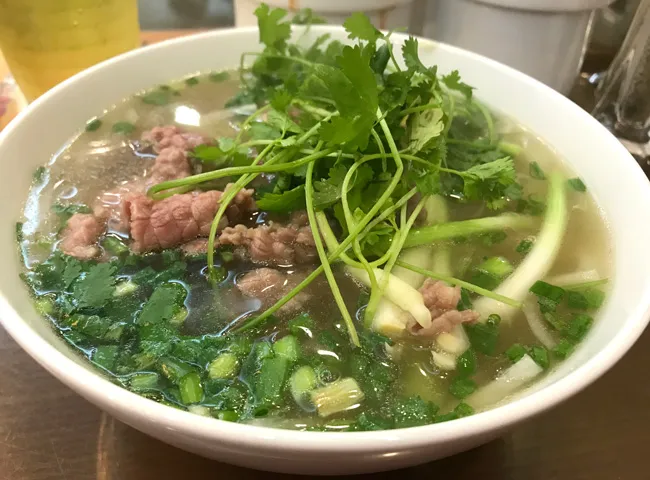 Classic bowl of Pho Bo, one of the essential Hanoi Specialties
Classic bowl of Pho Bo, one of the essential Hanoi Specialties
A classic bowl features delicate rice noodles swimming in a rich, marrow-infused beef broth. Thinly sliced beef (various cuts are available), fragrant ginger, and fresh spring onions complete the base. What makes Hanoi Pho truly special is the balance – the broth is clear yet profoundly flavorful, a result of meticulous simmering and seasoning.
Traditionally, Pho was the quintessential Hanoi breakfast, fueling locals on their way to work. While it’s now enjoyed throughout the day, there’s a certain magic to slurping a hot bowl on a cool Hanoi morning. Finding your favorite Pho spot is part of the adventure. I have a handful of go-to places depending on the day, but for that truly traditional, soul-warming broth, I often join the queue at famous spots known for their generations-old recipes. Remember to customize your bowl with a squeeze of lime or a dash of rice vinegar and a touch of chili paste – these seemingly small additions unlock incredible layers of flavor.
Bun Cha: The Iconic Grilled Pork with Vermicelli
If Pho is the king of Hanoi breakfast, then Bun Cha often reigns supreme at lunchtime. This dish beautifully showcases Vietnam’s expertise in crafting delicate rice noodles served with flavorful components. It’s a symphony of textures and tastes, a complete meal in a bowl that captures the essence of Hanoi street food.
Bun Cha consists of succulent, charcoal-grilled fatty pork patties and slices, served in a bowl of warm, sweet-and-sour dipping sauce made from diluted fish sauce, vinegar, sugar, and often slices of pickled kohlrabi and carrot. Alongside this flavorful broth comes a generous plate of fresh rice vermicelli noodles (Bun) and a vibrant assortment of fresh herbs like perilla, coriander, and lettuce.
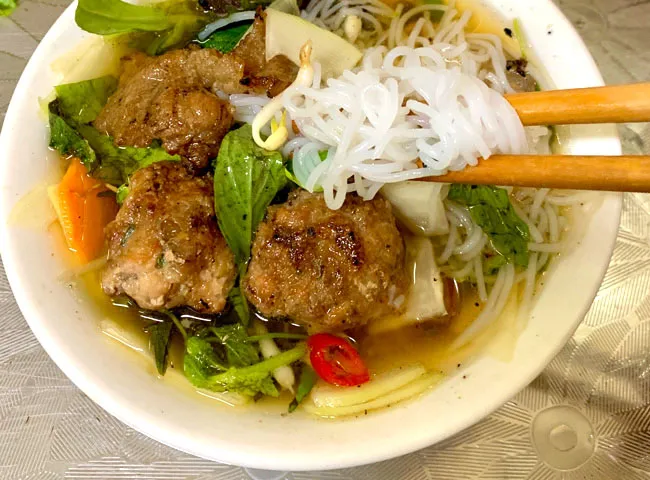 Bun Cha grilling on charcoal, a key Hanoi street food specialty
Bun Cha grilling on charcoal, a key Hanoi street food specialty
The sight and smell of Bun Cha are synonymous with Hanoi’s streets around midday. You’ll often see vendors grilling the pork right on the sidewalk, the smoky aroma wafting through the air – a sure sign you’re near a good spot. The ritual of eating Bun Cha involves dipping the noodles and herbs into the bowl of grilled pork and sauce, creating your perfect bite each time.
Many locals, including myself, enjoy Bun Cha at least once a week; the craving for that smoky grilled pork is real! For an extra indulgence, order some Nem Cua Be (crab spring rolls) to dip into the sauce as well. Don’t be shy with the herbs – they add freshness and complexity that elevate the dish.
Bun Thang: A Culinary Mosaic in a Bowl
Bun Thang, often described as “herbal medicine noodle soup” due to its numerous ingredients resembling the careful arrangement in traditional medicine, is a dish that exemplifies refinement and complexity in Hanoi’s culinary landscape. It’s a delicate and visually stunning noodle soup, showcasing a remarkable attention to detail.
The base of Bun Thang is a clear, subtle chicken or sometimes pork broth. What makes it stand out are the numerous toppings, meticulously prepared and arranged: fine strands of shredded chicken, thin strips of Vietnamese ham (gio lua), delicate threads of scrambled egg crepe, dried salted shrimp floss (tom bong), and shiitake mushrooms. It’s typically garnished with fresh green onions, Vietnamese coriander, and fried shallots, often with a few slices of red chili for a hint of heat.
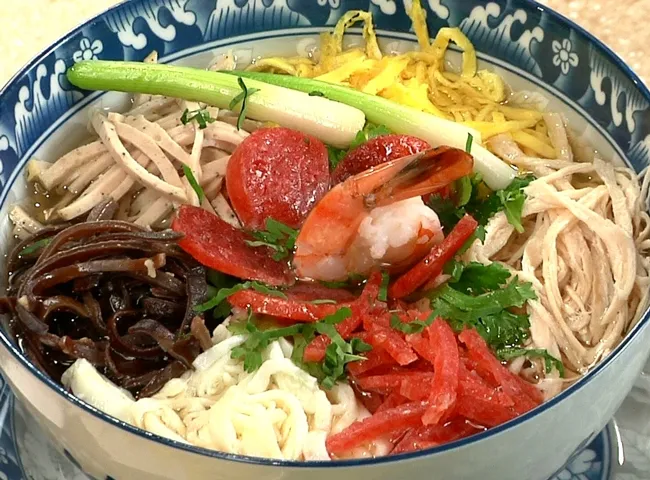 Beautifully arranged Bun Thang, a refined Hanoi Specialty soup
Beautifully arranged Bun Thang, a refined Hanoi Specialty soup
Unlike the robust flavors of Pho or Bun Cha, Bun Thang is characterized by its mildness and harmony. This subtlety allows the diner to appreciate the nuances of each ingredient. It’s served with a variety of condiments like lime, rice vinegar, and chili sauce, allowing you to adjust the flavor. Notably, a tiny dollop of shrimp paste (mam tom) is often offered. While potent on its own, when mixed into the hot broth, it transforms, adding a deep, earthy aroma without overpowering the delicate soup.
Eating Bun Thang feels like experiencing a piece of edible art, a testament to the sophistication that exists within Hanoi’s diverse food scene. It’s a dish often enjoyed on special occasions or when one desires something light yet profoundly flavorful.
Bun Ngan: A Late-Night Favorite
Shifting gears from daytime delights, Bun Ngan, or Muscovy duck noodle soup, holds a special place in Hanoi’s evening and late-night food scene. While Pho is available all day, Bun Ngan vendors start setting up as the sun begins to set, offering a warm and hearty meal that sustains locals well into the night.
Discover the Best Overnight Summer Camps in Texas
Your Ultimate Guide to Oktoberfest Los Angeles 2024
Discover the Best Things to See in Sarasota
This comforting soup features tender slices of boiled Muscovy duck served over soft rice vermicelli noodles (Bun), often accompanied by bamboo shoots. The broth is savory and aromatic, benefiting from the slow cooking of the duck. A variation, Mien Ngan, substitutes the rice vermicelli with translucent cellophane noodles, offering a slightly different texture.
 Hearty bowl of Bun Ngan, a popular Hanoi street food for dinner
Hearty bowl of Bun Ngan, a popular Hanoi street food for dinner
Bun Ngan is one of those genuine Hanoi specialties that isn’t easily found outside the city. Its prevalence on the streets after dark makes it an integral part of the city’s nocturnal rhythm. Wander through areas like the Old Quarter in the evening, and you’re likely to encounter the welcoming sight and smell of a Bun Ngan stall, often bustling with customers enjoying their dinner or late-night snack. The best spots are those where the duck has been simmered for hours, creating a wonderfully sweet and rich broth that perfectly complements the tender meat.
Banh Mi: The Vietnamese Baguette Reinvented
While the baguette arrived in Vietnam with the French, the Vietnamese took this simple bread and transformed it into a culinary icon known globally as Banh Mi. In Hanoi, the Banh Mi is a beloved staple, a perfect example of how foreign influences are seamlessly integrated and elevated within local culture.
Hanoi’s Banh Mi typically features a crispy yet airy baguette filled with a delectable mix of ingredients. Common fillings include roasted pork or chicken, homemade pork liver pâté (a rich and essential component), Vietnamese ham (gio lua), headcheese, pickled carrots and daikon, fresh cilantro, slices of cucumber, and a drizzle of chili sauce or soy sauce.
 Close-up of a half Banh Mi from Hanoi, showcasing its layers of filling
Close-up of a half Banh Mi from Hanoi, showcasing its layers of filling
The magic of Banh Mi lies in the harmony of contrasting flavors and textures: the crunch of the baguette, the richness of the pâté, the savoriness of the meat, the tang of the pickles, the freshness of the herbs, and the kick of the chili. Each bite is a symphony – spicy, salty, sour, savory, and aromatic all at once.
Once considered just a simple street food, Banh Mi has gained international fame and is now available everywhere from humble street carts to upscale cafes in Hanoi. It’s a versatile meal, perfect for breakfast, a quick lunch, or a satisfying snack. Experiencing a freshly made Banh Mi is an absolute must on any Hanoi food exploration, showcasing a delightful fusion history.
Seeking Out Hanoi’s Best Banh Mi
With Banh Mi stalls on nearly every corner, finding a good one is easy, but finding a great one is a true reward. One popular recommendation that lives up to its reputation is Banh Mi 25. They offer a variety of fillings, catering to different tastes, and their baguettes are consistently excellent. Pairing your Banh Mi with a cold local beer is a simple pleasure that enhances the experience of savoring this Hanoi specialty.
Cha Ca: Hanoi’s Signature Grilled Fish Dish
If any dish can claim to be the definitive Hanoi specialty, created by Hanoians for Hanoi, it is arguably Cha Ca. This unique dish, featuring grilled turmeric-marinated fish served with dill and vermicelli noodles, has a fascinating history tied to a specific family and even gave its name to a street in the Old Quarter.
The origin of Cha Ca dates back over 130 years to the Doan family, who served this specific grilled fish to Vietnamese patriots during the French colonial era. Its popularity was so immense and enduring that the street where their restaurant was located was officially named Cha Ca Street. This historical connection imbues the dish with a profound cultural significance.
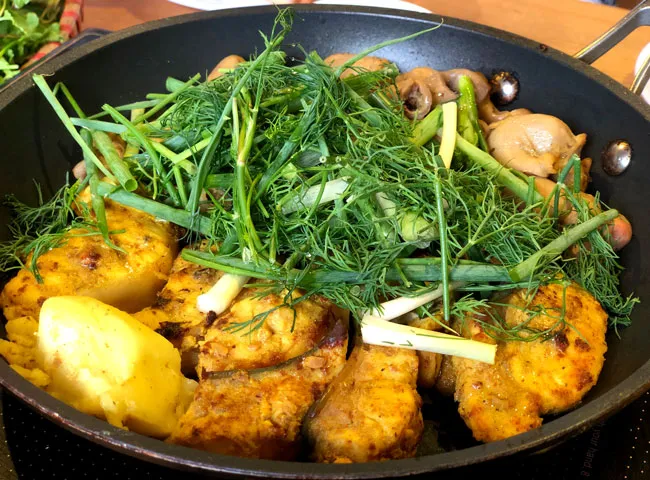 Cha Ca La Vong being cooked tableside, a historic Hanoi Specialty
Cha Ca La Vong being cooked tableside, a historic Hanoi Specialty
Cha Ca is less of a street food found everywhere and more of a specialty dish enjoyed at dedicated, often long-standing, restaurants. The core ingredient is usually catfish (or sometimes snakehead fish), marinated generously with turmeric, galangal, shrimp paste, and other spices. The unique experience is that the marinated fish, along with copious amounts of fresh dill and green onions, is brought to your table raw and cooked on a hot pan right in front of you.
It’s served with white rice vermicelli noodles (Bun), roasted peanuts, fresh herbs like mint and coriander, and a dipping sauce (often nuoc cham or sometimes a potent shrimp paste mixture). The aroma as the fish and dill cook is incredibly inviting. Eating Cha Ca is a communal and interactive experience, a delicious tradition preserved through generations. It’s a taste of Hanoi’s history on a plate.
Banh Com: The Sweet Green Sticky Rice Cake
Moving from savory to sweet, Banh Com is Hanoi’s quintessential traditional cake, deeply woven into the fabric of Northern Vietnamese culture, particularly in wedding rituals. This delightful treat is made from young sticky rice, offering a unique texture and a subtle, earthy sweetness.
The cake’s distinctive green color comes from the tender, unripe grains of sticky rice, harvested at a specific stage. These young grains are then processed into a soft, pliable paste. The filling is traditionally made from sweetened mung bean paste, often mixed with grated coconut and sometimes lotus seeds or lotus jam, adding layers of flavor and texture. The cakes are typically wrapped in banana leaves, which impart a delicate fragrance.
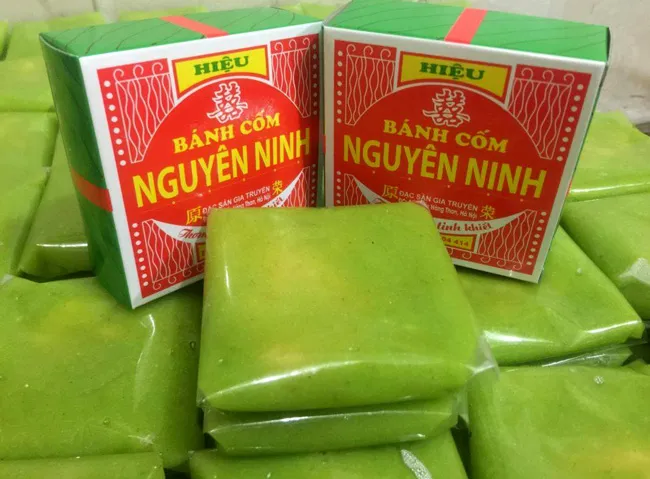 Green Banh Com cakes, a traditional sweet Hanoi Specialty
Green Banh Com cakes, a traditional sweet Hanoi Specialty
Banh Com is more than just a dessert; it’s a symbol of autumn, a taste of the harvest, and a representation of love and commitment, being an essential offering during traditional engagement ceremonies. Its flavor is subtly sweet, with the distinct aroma of the young rice. The texture is soft and slightly chewy from the sticky rice wrapper, contrasting with the smooth, sweet filling.
While available in many places, Hang Than Street in the Old Quarter is particularly famous for its numerous Banh Com shops, many run by families with decades of experience. My personal favorite is from a shop on this street, known for preserving the traditional techniques. Enjoying a piece of Banh Com with a cup of hot Vietnamese green tea is a perfect way to experience a beloved Hanoi tradition, a simple pleasure savored by generations.
Banh Cuon: Delicate Steamed Rice Rolls
Among the myriad breakfast options in Hanoi, Banh Cuon stands out as a delicate and elegant choice. These thin, steamed rice noodle rolls are a testament to the finesse of Vietnamese culinary techniques, particularly the mastery of rice batter.
Banh Cuon is made by steaming a very thin, wide sheet of fermented rice batter over a cloth stretched across a pot of boiling water. The steam quickly cooks the batter into a translucent, incredibly delicate wrapper. This wrapper is then typically filled with a mixture of seasoned ground pork, finely minced wood ear mushrooms, and shallots.
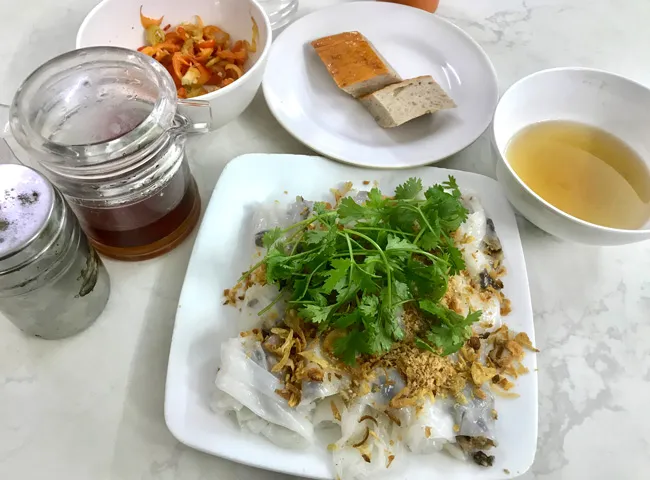 Platter of Banh Cuon with toppings and dipping sauce, a light Hanoi specialty
Platter of Banh Cuon with toppings and dipping sauce, a light Hanoi specialty
The rolls are usually served topped with fried shallots for a crispy texture and a scattering of fresh herbs like cilantro or mint. A crucial accompaniment is the dipping sauce, which is a light nuoc cham (fish sauce-based) sometimes subtly flavored with ca cuong essence – the essence of a giant water bug, which adds a unique, slightly aromatic note (though this is becoming less common). Often, a side of Vietnamese pork sausage (cha lua) is served alongside the Banh Cuon for extra flavor.
I have fond memories of watching vendors skillfully preparing Banh Cuon, the steam rising, the delicate sheets being lifted and filled. It’s a process that requires precision and speed. The resulting dish is light, flavorful, and incredibly satisfying, showcasing the versatility of rice in Vietnamese cuisine. It’s a perfect example of a seemingly simple dish executed with remarkable skill, making it a beloved Hanoi specialty.
Ca Phe Trung: The Rich and Creamy Egg Coffee
While Vietnam is renowned for its strong, delicious coffee often served with sweetened condensed milk, Hanoi offers a truly unique innovation: Ca Phe Trung, or Egg Coffee. Invented during a period of milk scarcity, this creative concoction has become an iconic Hanoi specialty and a must-try experience for coffee lovers and curious travelers alike.
The genius behind Egg Coffee was Mr. Giang, who in 1946, during the French resistance war, sought a substitute for milk to enrich his coffee. His solution was to whip egg yolk with sweetened condensed milk into a thick, creamy, meringue-like foam. This rich foam is then carefully layered over hot, strong Vietnamese coffee.
 Classic cup of Hanoi Egg Coffee with creamy foam topping
Classic cup of Hanoi Egg Coffee with creamy foam topping
The result is a drink that is surprisingly smooth and decadent. The bitterness of the coffee is beautifully balanced by the sweet, creamy richness of the egg foam. Many first-timers are surprised by the flavor, often comparing it to liquid tiramisu or a custard-like dessert. It’s typically served in a small glass, sometimes placed in a bowl of hot water to keep the coffee warm, allowing you to slowly savor the distinct layers.
The original Café Giang, founded by the inventor himself, remains one of the most popular spots to try Egg Coffee in Hanoi. Stepping into this often-hidden cafe, tucked away in the Old Quarter, feels like entering a piece of history. Beyond the classic Egg Coffee, many places now offer variations like egg matcha or egg chocolate, proving the enduring appeal of this ingenious Hanoian creation.
Kem Trang Tien: A Taste of Nostalgia
For many Hanoians, Kem Trang Tien isn’t just ice cream; it’s a taste of childhood and a symbol of simple pleasures. Established in 1958, this state-owned ice cream shop located near the Hanoi Opera House holds a special place in the city’s cultural landscape and is a beloved stop for locals and visitors alike.
Kem Trang Tien offers a no-frills experience focused solely on the ice cream itself. You choose your flavor from a range of options, often including classic vanilla, chocolate, coconut, and the uniquely Vietnamese young sticky rice (com). The ice cream is served immediately from freezers, either on a cone or as a bar.
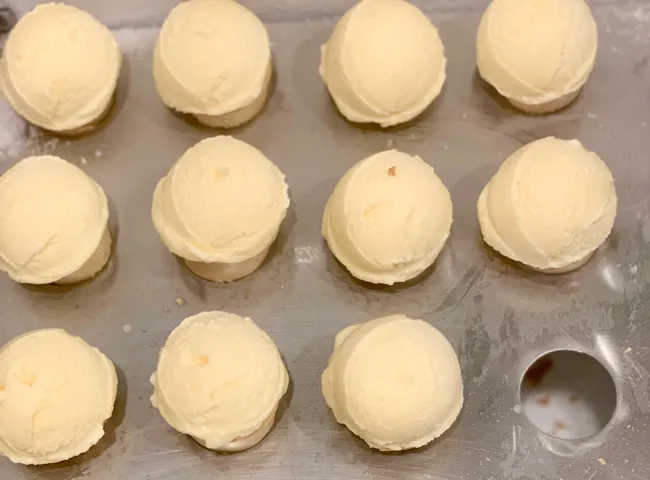 Trang Tien Ice Cream bar, a nostalgic Hanoi treat
Trang Tien Ice Cream bar, a nostalgic Hanoi treat
While perhaps not gourmet by modern standards, Kem Trang Tien’s ice cream is refreshingly simple and satisfying. It has a slightly icy texture and a balanced sweetness. The experience of eating it is as much about the atmosphere as the taste – joining the crowds gathered outside, enjoying a cool treat, and soaking in the lively ambiance, especially on warm evenings or weekends.
For many, including myself remembering stories from my uncle who lived in the city, a trip to Hanoi wasn’t complete without a Kem Trang Tien ice cream. It represents an enduring piece of the city’s recent history and a simple, joyful moment shared by generations. It’s a perfect, light way to end an evening stroll or a food tour, leaving you with a sweet memory of Hanoi.
The Fabric of Hanoi Through Its Food
Exploring these Hanoi Specialties offers more than just a culinary tour; it provides a profound insight into the city’s history, culture, and resilience. Each dish tells a story, whether it’s the evolution of Pho, the historical significance of Cha Ca, the cultural importance of Banh Com, or the innovative spirit behind Egg Coffee.
The street food culture, in particular, is the city’s lifeblood. It’s where you see the daily rhythm unfold, where generations-old recipes are perfected in plain sight, and where the community gathers. Learning how to navigate the street stalls, understanding the customs (like adding herbs to Bun Cha or condiments to Pho), and simply being open to trying new things are all part of the rich experience.
These dishes are interconnected, forming a delicious web that defines Hanoi’s identity. They showcase the city’s ability to preserve tradition while embracing innovation, using simple ingredients to create complex and unforgettable flavors.
Frequently Asked Questions about Hanoi Specialties
What are the absolute must-try Hanoi Specialties for a first-time visitor?
If you only have time for a few, prioritize Pho Bo (beef noodle soup), Bun Cha (grilled pork with vermicelli), and Ca Phe Trung (egg coffee). These three arguably represent the most iconic and uniquely Hanoian flavors. Cha Ca is also highly recommended for its historical significance and unique dining experience.
Are there vegetarian or vegan Hanoi Specialties?
While many traditional Hanoi specialties are meat- or fish-based, the city is becoming more accommodating. You can often find vegetarian Pho (Pho Chay) and Banh Cuon Chay (vegetarian rice rolls). Look for vegetarian versions of spring rolls (Nem Chay). Some restaurants specialize in vegetarian Vietnamese cuisine that offers plant-based takes on classic flavors.
How do I find the best places to eat Hanoi Specialties?
The best way is often to follow the locals! Look for stalls or restaurants that are busy, especially during peak hours (morning for Pho, lunch for Bun Cha, evening for Bun Ngan). Ask locals for recommendations. Food tours are also excellent for discovering hidden gems and learning about the food from a local expert.
What is the best time of year to visit Hanoi for food?
Hanoi’s food is delicious year-round, but the cooler, dry weather of autumn (September to November) and spring (March to April) is often considered the most comfortable for exploring the street food scene. The heat and humidity of summer can be intense, while winter can be quite chilly.
Plan Your Culinary Adventure
Savoring Hanoi Specialties is more than just eating; it’s an immersive cultural experience. It’s about understanding the stories behind the dishes, appreciating the skills of the cooks, and connecting with the local way of life through its most delicious medium. From the steaming bowls of Pho to the sweet layers of Banh Com, each bite invites you deeper into the heart of this captivating city. Don’t just visit Hanoi; taste it, live it, and let its incredible culinary heritage leave an indelible mark on your travel memories.
